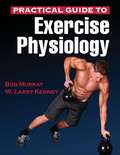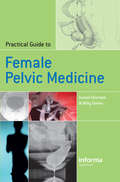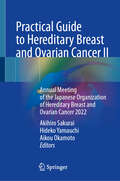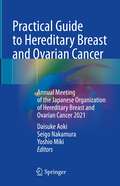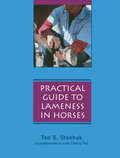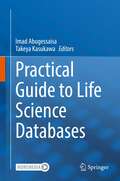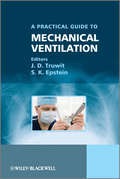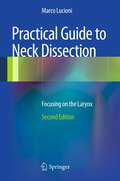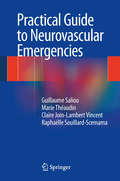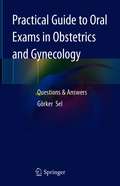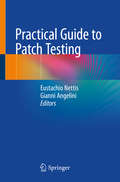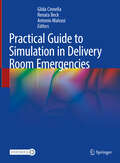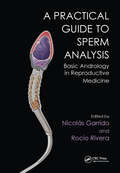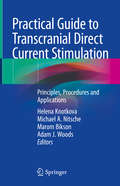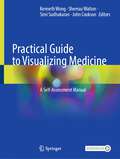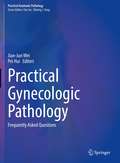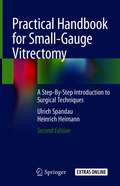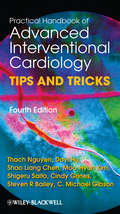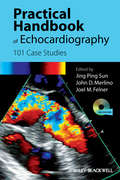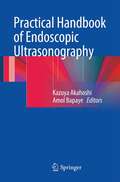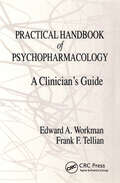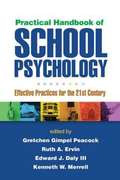- Table View
- List View
Practical Guide to Exercise Physiology
by Murray Robert; W. Larry KenneyIt contains all the necessary information for new and current personal trainers and fitness professionals. Readers will gain confidence in designing exercise programs for various populations and the ability to explain to clients how each exercise and movement will help them achieve their goals.
Practical Guide to Female Pelvic Medicine
by Gamal Ghoniem G Willy DavilaPelvic floor disorders affect a large proportion of women worldwide. This book is a highly practical guide highlighting all the varying forms of such problems. Included are chapters on the pathophysiology of the female pelvic floor, the evaluation and diagnosis of problems, the practical management of symptoms, and the complications that can arise
Practical Guide to Hereditary Breast and Ovarian Cancer II: Annual Meeting of the Japanese Organization of Hereditary Breast and Ovarian Cancer 2022
by Akihiro Sakurai Hideko Yamauchi Aikou OkamotoThis book shares cutting-edge evidence on Hereditary Breast and Ovarian Cancer (HBOC) treatment, delivering facts on breast cancer, gynecologic oncology, and basic research to contribute to clinicians' practices. It is based on the best-chosen works presented at the Japanese Organization of Hereditary Brest and Ovarian Cancer (JOHBOC) in 2022. The volume collectively provides a comprehensive view of HBOC management with the aim to contribute to the equalization and dissemination of HBOC practice as well as to serve as a foundation for future advances in the treatment of the diseases and medical practice. While it sheds light on the present state of HBOC management in Japan, whose cases are on the increase due to partial coverage by public insurance of the HBOC diagnosis and treatment, the scope of topics covered maximizes reader insight into the latest clinical techniques, basic experimental results along with clinical controversy. Practical Guide to Hereditary Breast and Ovarian Cancer II – Annual Meeting of JOHBOC aims to entertain a broad readership and serves as a valuable resource for professionals involved in HBOC treatment, including breast surgeons, obstetricians, gynecologists, pancreatic cancer surgeons, and urologists. The current information is crucial for informed decision-making and practice, making it beneficial for certified genetic counselors and medical staff specializing in HBOC. Additionally, it serves as an excellent reference for HBOC patients and their families.
Practical Guide to Hereditary Breast and Ovarian Cancer: Annual Meeting of the Japanese Organization of Hereditary Breast and Ovarian Cancer 2021
by Seigo Nakamura Daisuke Aoki Yoshio MikiThis book shares cutting-edge evidence on Hereditary Breast and Ovarian Cancer (HBOC) treatment, delivering facts on breast cancer, gynecologic oncology, and basic research to contribute to clinicians' practices. Each chapter presents the latest clinical techniques, basic experimental results, and the best-chosen research findings. The book is based on the works presented at the Japanese Organization of Hereditary Brest and Ovarian Cancer (JOHBOC) and a special chapter delivers a study based on the extensive data from the Japanese HBOC patients registered in the society's database, presenting novel evidence for further advancement in the field. The practice for HBOC has been rapidly increasing due to the clinical development of poly(ADP-ribose) polymerase inhibitors and the spread of companion diagnostics. In addition, the insurance coverage of a part of HBOC treatment raised social awareness in Japan, and the book illustrates not only clinical efforts but also issues related to the social system and the efforts of the association of related organizations. Hereditary Breast and Ovarian Cancer – Annual meeting of JOHBOC will be of interest to breast surgeons, obstetricians and gynecologists, pancreatic cancer surgeons, and urologists engaged in HBOC treatment through the implementation of companion diagnostics for PARP inhibitors administration. Also, physicians occupied in genetic medicine who perform genetic testing and medical staff practicing HBOC will find this book insightful. It is also for HBOC patients and their families, medical administrators in the social system of HBOC practice. Editors and authors hope to contribute to the equalization and widespread of HBOC practice and serve as a foundation for future advances in the disease's treatment and medical practice.
Practical Guide to Lameness in Horses
by Ted S. Stashak Cherry HillThis is an updated, practical version of Dr. Stashak's top selling book Adams' Lameness in Horses, 4th edition. The material is heavily illustrated and provides a hands-on guide to common clinical problems. <P><P>The authors present important guidelines for decision making and preventive measures. This is a hands-on, authoritative resource that clearly differentiates between important and non-important clinical situations.
Practical Guide to Life Science Databases
by Imad Abugessaisa Takeya KasukawaThis book provides the latest information of life science databases that center in the life science research and drive the development of the field. It introduces the fundamental principles, rationales and methodologies of creating and updating life science databases. The book brings together expertise and renowned researchers in the field of life science databases and brings their experience and tools at the fingertips of the researcher. The book takes bottom-up approach to explain the structure, content and the usability of life science database. Detailed explanation of the content, structure, query and data retrieval are discussed to provide practical use of life science database and to enable the reader to use database and provided tools in practice. The readers will learn the necessary knowledge about the untapped opportunities available in life science databases and how it could be used so as to advance basic research and applied research findings and transforming them to the benefit of human life.Chapter 2 is available open access under a Creative Commons Attribution 4.0 International License via link.springer.com.
Practical Guide to Mechanical Ventilation
by J. D. Truwit S. K. EpsteinA new, case-oriented and practical guide to one of the core techniques in respiratory medicine and critical care.Concise, practical reference designed for use in the critical care settingCase-oriented content is organised according to commonly encountered clinical scenariosFlow charts and algorithms delineate appropriate treatment protocols
Practical Guide to Neck Dissection
by Marco LucioniThis is the second edition of a superbly illustrated manual on neck dissection that will serve as a roadmap for advanced surgeons and beginners alike. The reader is guided through the various cervical structures in a series of chapters depicting the methods employed by surgeons operating in vivo. The illustrations provide an overview of all surgical anatomy relevant to the treatment of oncologic patients. Compared with the first edition, revisions have been made when appropriate and an important new chapter has been added on microscopic anatomy and laryngeal cancer. This chapter, which will also be of interest to pathologists, documents the microscopic anatomy of the larynx, presents patterns of spread and surgical options, and depicts the major surgical procedures on the larynx with the aid of numerous photographs and line drawings. As with the first edition, an accompanying DVD provides video clips demonstrating surgical techniques.
Practical Guide to Neurovascular Emergencies
by Claire Join-Lambert Raphaëlle Souillard-Scemama Guillaume Saliou Marie ThéaudinModern vascular neurology, particularly in the emergency setting, often requires a great capacity for analysis and synthesis. Physicians who manage these patients must have acquired multidisciplinary skills, including a good knowledge of clinical neurology and medical imaging, but they may also need to be skilled in cardiology and intensive care. The initial clinical and imaging examinations play a decisive role in the management strategy. This book, written by neurologists and neuroradiologists, is designed to help all physicians involved in the management of neurovascular disease. The format and contents of this book, including the latest guidelines from learned societies, are designed to provide a succinct and practical guide. Although this book is particularly devoted to ischaemic stroke, other neurovascular diseases, especially haemorrhagic stroke, are also discussed. This book should constitute a valuable tool for everyday practice for all medical personnel involved in neurovascular disease.
Practical Guide to Oral Exams in Obstetrics and Gynecology: Questions & Answers
by Görker SelThis book, based on non-interactive question-and-answer format, offers an essential guide for medical students who need to prepare for oral exams or clinical visits. Starting from specific clinical situations the volume provides clear questions on the theory related to the cases. Each question is followed by correct answers that summarize the main information. Suggested reading are included to deepen the topics and enhance the readers knowledge. Accordingly, this practical guide will help students get ready for their oral exams, and help prepare young residents for their first clinical cases.
Practical Guide to Patch Testing
by Gianni Angelini Eustachio NettisThis volume provides allergy and dermatology specialists with a practical guide to the correct patch test methodology for their day-to-day clinical practice: it includes the latest available hapten series (standard series and integrative series), the golden rules for concentration and conservation of the haptens themselves, and the indispensable test equipment. The book, coming in a handy softcover format, is also nicely illustrated with over 100 full color pictures and tables. The contents focus on the interpretation of the epicutaneous test reading as well, relating to clinical relevance of the reactions and granting a correct management of the allergic patient. Practical Guide to Patch Testing will be of great value to all practicing allergists or dermatologists and professionals related.
Practical Guide to Simulation in Delivery Room Emergencies
by Antonio Malvasi Gilda Cinnella Renata BeckIn this book the use of hybrid simulation in delivery room emergencies is described and shown. The use of a patient actor combined with a task trainer within the same session substantially improve the training for practical management of intrapartum emergencies in real life, reducing the risk of failure of operative vaginal delivery and of related adverse events, including perinatal or maternal complications. Furthermore, simulation with high reality computerized mannequin and scenography of emergency situation can improve technical and manual skills of the participants. For this book and the related videos, a new generation of mannequins suitable for both clinical manoeuvres and ultrasound examination is used to simulate all clinical scenarios of emergency that can happen in the delivery room for both the mother and the child. This unique book is a useful tool for medical students, residents, practicing pediatricians, anesthetists, obstetricians and all health care professionals working in the delivery room in their ability to deal with critical and emergency situations with safety and good medical practice.
Practical Guide to Sperm Analysis: Basic Andrology in Reproductive Medicine
by Nicolás Garrido Rocio RiveraThis is a reference manual for daily use in the Reproductive Medicine or Andrology laboratory, which goes beyond the literature available in the scientific journals by compiling insights into a detailed and applied clinical approach. All established practitioners in Reproductive Medicine will find much of practical relevance about the latest insights into sperm selection and analysis.
Practical Guide to Transcranial Direct Current Stimulation: Principles, Procedures and Applications
by Helena Knotkova Michael A. Nitsche Marom Bikson Adam J. WoodsThis book provides a comprehensive overview on Transcranial Direct Current Stimulation (tDCS) and the clinical applications of this promising technique. Separated into three parts, the book begins with basic principles, mechanisms and approaches of tDCS. This is followed by a step-by-step practicum, methodological considerations and ethics and professional conduct pertaining to this novel technique. Chapters are authored by renowned experts who also direct and plan tDCS educational events worldwide. Bridging the existing gap in instructional materials for tDCS while addressing growing interest in education in this field, professionals within a broad range of medical disciplines will find this text to be an invaluable guide.
Practical Guide to Visualizing Medicine: A Self-Assessment Manual
by Simi Sudhakaran John Cookson Kenneth Wong Shernaz WaltonThis book provides a practically orientated resource that details the use a range of imaging techniques across major specialties plus those that are less well represented in standard textbooks (e.g. cardiothoracic surgery, palliative care, geriatric medicine, skin conditions from diverse ethnic groups). Emphasis is placed on enabling the reader to interpret images and clinical data, while avoiding mistakes and pitfalls in their day-to-day practice. Detailed question and answer sections along with insightful videos reinforce key messages (e.g. visualizing heart murmurs). Grading of questions aids navigation, with more difficult questions to benefit the high-flying students/junior doctors preparing for postgraduate exams/physician associates and advanced nurse practitioners working in a specialist area.Practical Guide to Visualizing Medicine: A Self-Assessment Manual concisely covers how to use imaging techniques in medicine, surgery, pediatrics, obstetrics and gynecology. It emphasizes the value of being able to accurately visualize signs and symptoms to make accurate diagnoses and provide patient-centered care. The added insight given from experienced medical educators on how to select an appropriate medical specialty makes this work critical for all trainee and early-career medical practitioners and allied healthcare professionals.
Practical Gynaecological Ultrasound
by Jane BatesDevoted solely to gynecological ultrasound, this book covers normal anatomy and physiology as well as pathological processes. With excellent diagrams and halftones it illustrates the key technical and diagnostic steps needed by both the trainee and established radiographer, radiologist and gynecologist, providing clear guidance on the optimum management of patients undergoing gynecological investigation by ultrasound. Key topics include: normal anatomy and physiology; pathology of the uterus, ovaries and related pelvic structures; the acute pelvis; ovarian screening; infertility; pediatric gynecological ultrasound; and management of the gynecological patient.
Practical Gynecologic Pathology: Frequently Asked Questions (Practical Anatomic Pathology)
by Pei Hui Jian-Jun WeiThis book serves as a quick review or summary of major diagnostic challenges in gynecologic pathology and embraces a Q/A format by providing the desired diagnostic knowledge. It combines the diagnostic approach as it relates to morphology and the relevant ancillary tests which impact on clinical outcome or management. Each topic is written by subspecialty gynecological pathologists in the field in making this a valuable book for a broad spectrum of readers, particularly pathology trainees, junior pathologists and general practicing pathologists. These authors provide concise and accurate answers for a variety of common, yet challenging diagnostic scenarios that are relevant and frequently encountered in daily practice. The book walks readers through current topics, controversies and diagnostic dilemmas for common gynecologic diseases with morphologic features and key ancillary tests, richly illustrated with figures and tables. To reflex the current advances in diagnostic gynecological pathology, the topics are closely correlated with the updated disease classifications and diagnostic criteria, particularly those recognized by the World Health Organization. Practical Gynecologic Pathology provides a concise summary and review for some of the most difficult, prevailing and emerging concepts in gynecologic pathology.
Practical Handbook for Small-Gauge Vitrectomy
by Ulrich Spandau Heinrich HeimannSince the development of 23G vitrectomy in 2004, the technique has revolutionized retinal surgery by overcoming a number of the problems associated with 20G and 25G systems and offering significant improvements in surgical capability and fluidics. This important book first discusses the instruments and equipment employed in 23G vitrectomy and then explains, step by step, the various surgical techniques with the aid of informative diagrams and many high-quality photos. In addition, videos are included that document the different procedures, from the straightforward to the demanding. This book will serve as an immensely useful guide for all surgeons who are intending to make use of this exciting and increasingly used technique.
Practical Handbook for Small-Gauge Vitrectomy: A Step-by-step Introduction To Surgical Techniques
by Ulrich Spandau Heinrich HeimannSince publication of the first edition of this book in 2012 vitreoretinal surgery has marched with huge steps forward. In 2012 23G was standard, today 25G and 27G are the most commonly used gauge sizes for vitrectomy. In 2012 the cutting rate was 5.000 cuts/min and today with the development of a novel vitreous cutter the cutting rate has increased to 16.000 cuts/min. The advent of 25G/27G made the instruments smaller and surgery less traumatic. Practical Handbook for Small-Gauge Vitrectomy: A Step-By-Step Introduction to Surgical Techniques, 2ndEdition focuses on these new developments and features new chapters on PVR detachment, intraocular tumour, macular translocation, sub macular hemorrhages and ocular trauma. The surgeries are demonstrated step-by-step and the material is shown in detail and videos visualize the surgery.This book will serve as an immensely useful guide for all surgeons who are intending to make use of this exciting and increasingly used technique.
Practical Handbook of Advanced Interventional Cardiology
by Shigeru Saito Steven R. Bailey Cindy Grines C. Michael Gibson Shao Liang Chen Thach Nguyen Dayi Hu Moo-Hyun KimContinued advances in cardiology have led to unprecedented scientific progress in recent years. However, no matter how advanced the science, the successful application of interventional cardiology relies upon a practitioner's ability to approach interventional techniques competently and confidently in every situation. Fully updated and featuring new chapters and additional tips and tricks, this latest edition of Dr Nguyen, Colombo, Hu, Grines, and Saito's celebrated book provides a complete yet concise guide to practical interventional cardiology that deserves a place in every cardiac laboratory. Culled from the personal experience of over fifty international experts, the book incorporates more than 500 practical tips and tricks for performing interventional cardiovascular procedures. Each strategic or tactical move is graded by complexity level and described in a simple, step-by-step approach that includes guidance on how to overcome practical difficulties, providing a comprehensive resource that can benefit both beginner or experienced operators. As well as covering the latest developments in interventional cardiology, this third edition includes technical tips that promote user-friendly performance, low complication rates, cost- and time-efficient approaches and cost- and time-effective selection of devices to help optimize the practice of modern interventional cardiology.
Practical Handbook of Advanced Interventional Cardiology: Tips and Tricks
by C. Michael Gibson Shao Liang Chen Moo-Hyun Kim Cindy L. Grines Thach N. Nguyen Duane S. Pinto Ernest F. TalaricoA concise and convenient pocket guide to interventional cardiology’s latest procedures and technologies Interventional cardiology is growing more and more integral to the modern-day management of cardiovascular problems. Indeed, trainees are taught interventional methods as a matter of course. With a widening range of options open to them, however, the practicing cardiologist must be diligent and discerning when selecting the appropriate course of action for each patient, adapting their strategy as circumstance demands. Developing the skills and experience necessary to make these key judgments can be a challenging and lengthy process. Bringing together the knowledge of an international group of over 50 experts, this fifth edition of the Practical Handbook of Advanced Interventional Cardiology helps cardiologists of all levels to find interventional solutions to a wide range of problems. Its revised contents cover topics including new devices, valve procedures, and venous and atrial occlusion, and also feature new chapters on bioresorbable vascular scaffolds, protected percutaneous coronary intervention, coronary atherectomy, pulmonary embolism, and more. This essential companion: Offers clear, easy-to-follow guidance for cardiology practitioners of all levels of skill and experience Grades each strategic or tactical action by level of complexity Includes full-color clinical images and illustrations Covers all key interventional procedures and techniques Provides practical tips and tricks for handling difficult clinical scenarios and complications The Practical Handbook of Advanced Interventional Cardiology is an invaluable resource for both practitioners and trainees in interventional cardiology and all related areas of cardiovascular medicine.
Practical Handbook of Echocardiography: 101 Case Studies
by Joel Felner John Merlino Jing Ping SunPractical Handbook of Echocardiography: 101 Case Studies Echocardiography is now one of the most commonly used diagnostic imaging tools, yet many clinicians remain unaware of the range of conditions echo can reveal or how echo can be used to help plan therapy. Moreover, it can be quite challenging even for the most seasoned practitioners to spot unusual conditions. Compiled by three echocardiographers with more than 100 years of clinical experience between them, Practical Handbook of Echocardiography uses a case-based approach to explain in detail the full spectrum of echocardiographic modalities and how to optimize their use in the clinical setting. This practical new book: Covers the full gamut of echocardiographic modalities, including M-mode, 2-D,3-D and Doppler (PW, CW, color flow, tissue and strain), transesophageal (intra-operative and routine) and contrast Describes cases in both clinical and echocardiographic terms including very interesting cases and the new clinical techniques Features beautifully reproduced, well-labeled, full color echocardiograms Includes accompanying DVD with real-time video clips Appropriate for physician echocardiographers and all cardiologists, as well as echocardiographic technicians, Practical Handbook of Echocardiography is the ideal concise guide to using echocardiography to make definitive diagnoses and improve patient outcomes.
Practical Handbook of Endoscopic Ultrasonography
by Amol Bapaye Kazuya AkahoshiEndoscopic ultrasonography (EUS) has evolved from an obscure method of investigation in the 1980s to a distinct endoscopy subspecialty with interventional and therapeutic capabilities. The art of interpreting EUS images is a skill every endoscopist needs to master. This book helps to meet that need as it is concise, simple to read, and amply illustrated, and describes the technique in a step-by-step manner. Many high-resolution EUS images of diseases are included, and literature reviews are kept short and concise while separate discussions and illustrations are devoted to radial and linear techniques. The book can be used as a reference handbook in the endoscopy room, yet contains all of the relevant information required to perform EUS, interpret images, and reach a diagnosis. Important pathological conditions are thoroughly discussed using representative EUS images, pointing out salient differentiating features, and relevant literature reviews are included. The section on interventional EUS deals with advanced interventional or therapeutic procedures, and potential complications and methods to avoid them are discussed. For the novice, the book is designed to teach EUS using a step-by-step approach, and for the seasoned endosonographer it is a practical reference tool for use while performing EUS and may also serve in the differentiation of various pathologies.
Practical Handbook of Psychopharmacology: A Clinician's Guide
by Edward A. Workman Frank F. TellianPhysicians of the 1990s cannot afford to spend valuable time combing through volumes of laborious discussions of tedious details on psychiatric drugs. Practical Handbook of Psychopharmacology is the most comprehensive, yet user-friendly guide to psychotropic medication available in any single source. Text is minimized and straight to the point, with critical clinical information given in two forms. First, highly useful tables with the relevant basic information on all major psychotropic drugs are provided. The book also contains clinical flowcharts or tabular practice guidelines that assist in making everyday decisions about the use of psychotropics. Unique chapters discuss the psychopharmacology of pain, personality disorders, aggression, and children/adolescents, while other chapters cover standard areas such as depression, mania, psychosis, and dementia.
Practical Handbook of School Psychology
by Gretchen Gimpel Peacock Ruth ErvinBringing together leading authorities, this state-of-the-science handbook delves into all aspects of problem-solving-based school psychology practice. Thirty-four focused chapters present data-based methods for assessment, analysis, intervention, and evaluation, with special attention given to working in a response-to-intervention framework. Tools and guidelines are provided for promoting success in key academic domains reading, writing, and math. Social-emotional and behavioral skills are thoroughly addressed in chapters on self-management interventions, peer and family support, cognitive-behavioral interventions, medication use, and more. This accessible work is an invaluable reference for practitioners and an ideal resource for school psychology training programs.
